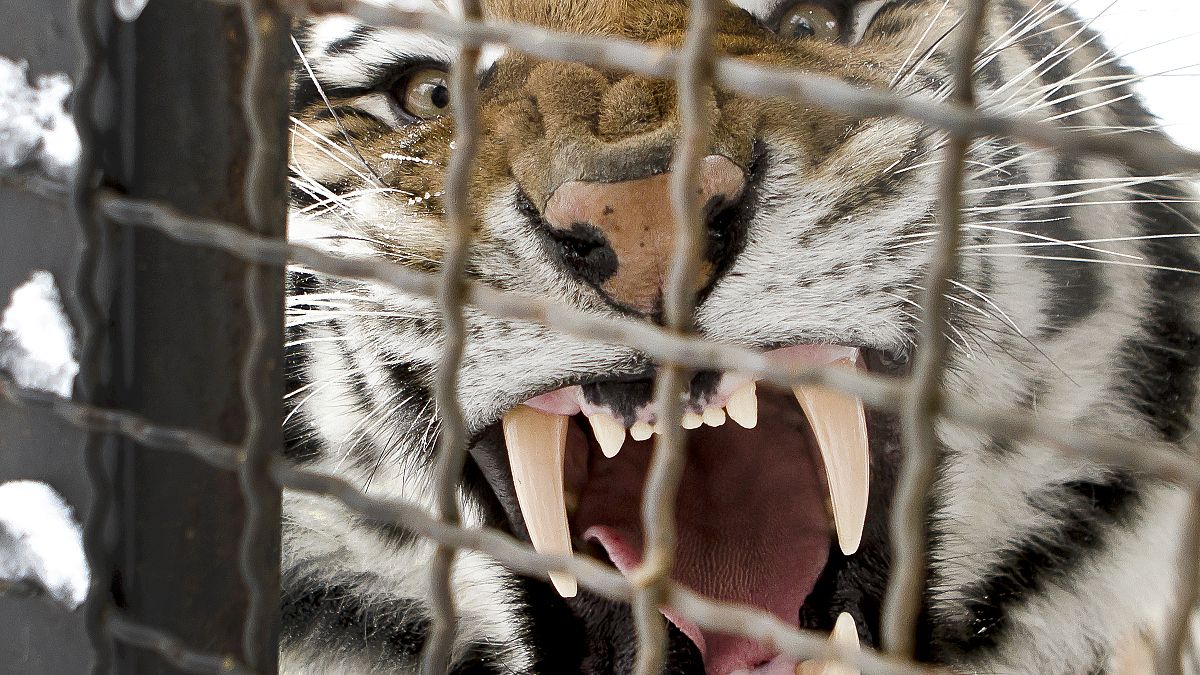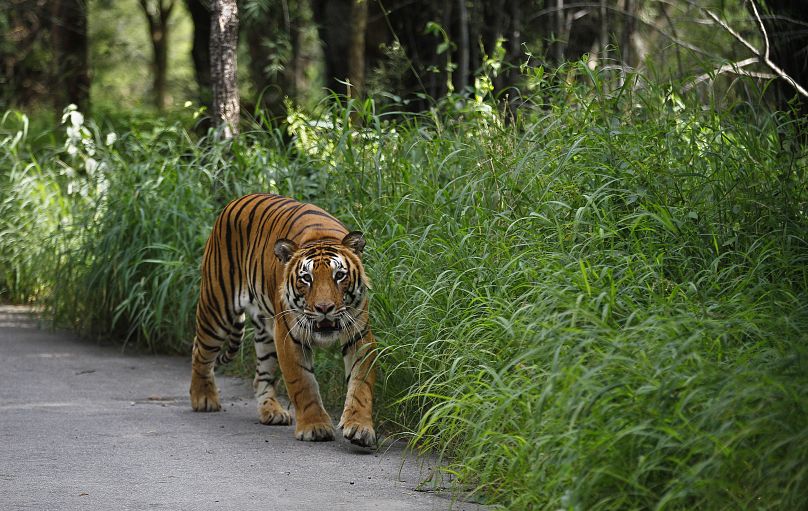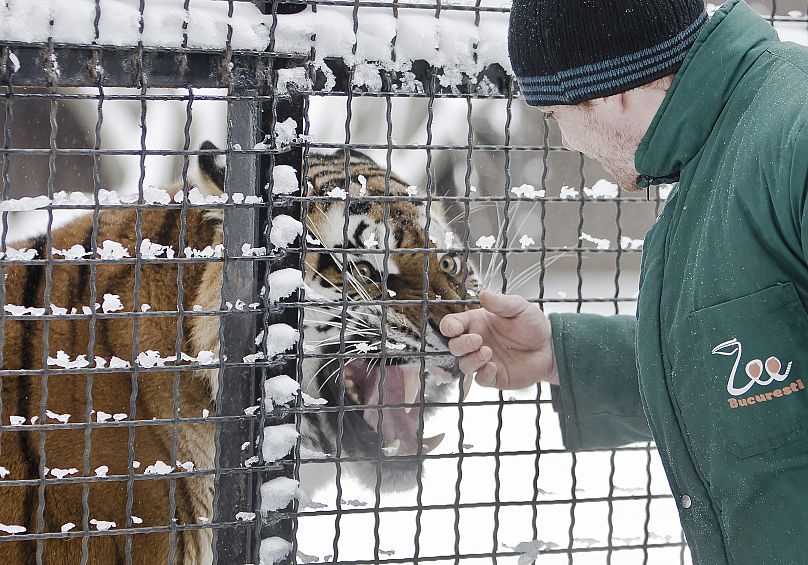There are at least 1,600 captive tigers in Europe, compared to just 3,900 wild globally, according to the global animal welfare organisation, FOUR PAWS. Activists say the trade of animals is “poorly regulated and monitored” in the EU and many animals are suffering abuse in terrible conditions.
The number of captive tigers in Europe and the US is more than double the number left in the wild, according to a new report.
There are at least 1,600 captive tigers in Europe, compared to just 3,900 wild globally, says the global animal welfare organisation, FOUR PAWS.
FOUR PAWS state that tigers and cubs are being used as photo props and for selfies at facilities in countries including France, Germany, Spain and Malta.
"We know of one place where it is €50 for 10 minutes with a big cat cub," said Kieran Harkin, Head of Wildlife Animals in Trade at FOUR PAWS International.
It is estimated that many tigers eventually “lose their commercial value” and their body parts are sold for use in “traditional medicine” in Asian markets like China and Vietnam.
Previous data from 2018 had officially documented only 698 captive tigers in Europe, according to the Convention on the International Trade in Endangered Species of Wild Fauna and Flora (CITES).
The new report comes just one month after a controversial Netflix true crime documentary ‘Tiger King’ exposed the breeding and trade of tigers in the United States.
FOUR PAWS told Euronews their concern that the demand for breeding cubs could result in a "never-ending cycle".
Horror stories of tigers being driven "in the back of cars"
The private ownership of exotic pets, and the use of tigers in circuses is still legal in a number of EU countries, but FOUR PAWS says the trade is “poorly regulated and monitored” and many animals are suffering abuse in terrible conditions.
"Its quite easy for anyone to source and purchase a tiger in countries where private keeping is still legal," Kieran Harkin told Euronews.
"You only need to show enclosures and some authorities are not qualified enough to check if these enclosures are adequate enough for a tiger’s welfare".
While owners usually have to apply for import and export permits, but Kieran Harkin says the European Union offers an exemption to this across borders.
"There are very few checks and we have heard all sorts of horror stories of people driving tigers and other big cat species in the back of cars".
Most European countries also require prospective owners to have a licence for keeping a dangerous animal, but Harkin says the application and issuing of these licenses is "also quite an easy process".
FOUR PAWS also told Euronews that the sale of tigers for commercial gain can be a "highly lucrative industry".
A live tiger captive-bred in Europe can reportedly be worth up to €22,000, while a kilo of tiger bones could be valued at €1,700.
Which European countries have the most captive tigers?
CITES prohibits the commercial trade of wild tigers, and aims to ensure that any legal trade of tigers and parts has no impact on the survival of the species. But captive tigers are listed under a separate CITES Appendix, which does allow for their legal trade.
The Czech Republic and Germany have reported the highest figures of captive tigers in Europe, with 180 and 164 respectively.
Meanwhile, the United Kingdom, where the private keeping of captive tigers is legal, is third in the continent with 123 recorded animals.
Slovakia also reported 119 captive tigers, despite CITES recording just 3 in the EU country in 2018.
Just 17 of the 36 European countries contacted by FOUR PAWS, including only 12 EU member states, responded with figures.
NGOs estimate that Italy, one of those countries which did not respond, has 400 tigers kept in zoos, private homes and circuses.
FOUR PAWS says that many captive animals cannot be rehabilitated into the wild, while their illegal trade also fuels the demand for worldwide poaching of wild tigers.
"There will always be a higher onus on a wild tiger than a captive tiger, so by stimulating a greater demand for captive tigers, you’re actually placing more threat on wild populations," said Harkin.
"More efforts are needed," admits the EU as further measures considered
FOUR PAWS has urgently called on the European Union to "suspend the export and re-export of live tigers and tiger parts", except to legitimate sanctuaries.
The animal welfare organisation has further recommended that the EU introduces a comprehensive ban on commercial tiger trade to combat animal abuse.
"We need the EU to turn off the tap and stop this influx of tigers, and stop this breeding and distribution of tigers for different reasons, for circuses, for private keeping, and for petting across Europe," Harkin told Euronews.
"If we stop the commercial trade, and the only tigers that we see or are being bred across Europe have a legitimate conservation process, then that’s the ideal situation".
"We do not need to be petting tigers, breeding hybrids and all this other entertainment".
FOUR PAWS has previously launched projects focusing on the suffering of animals which are kept in inappropriate conditions, as well as in disaster and conflict zones.
The European Commission adopted an Action Plan against Wildlife Trafficking in February 2016 to improve efforts against wildlife crime in the EU.
But despite encouraging signs, the Commission has said that “more efforts are needed” to combat the illegal trade of exotic animals.
“Wildlife trafficking continues to pose a serious threat to biodiversity, the rule of law and sustainable development, said Karmenu Vella, European Commissioner for the Environment, Maritime Affairs and Fisheries, in 2018.
“We need to further intensify our efforts to reach the objectives of the Action Plan by 2020, and meet the target of the UN 2030 Agenda for Sustainable Development”.
"The European Union have been very good, working in other areas of the world when it comes to illegal wildlife trade," said Harkin, "but it needs to look internally at its own jurisdictions".
"We need a greater political appetite to do more and greater enforcement in Europe".
Progress on the European Commission action plan is due to be assessed later this year. In a further statement to Euronews, a Commission source agreed that tigers need to be strictly protected.
"The Commission has therefore closely followed the recent cases of illegal trade in tigers in several EU Member States, and facilitated the exchange of relevant information among enforcement authorities through its expert group on wildlife trade enforcement."
The EU say that, while there is no central register of tigers kept in the EU, authorities with member states have the responsibility and capability to control the keeping and breeding of tigers.
"The Commission has intensified its cooperation with the relevant enforcement authorities of the Member States and has asked them to pay special attention to these issues."
"[We] will continue to monitor the situation, together with the CITES authorities of EU Member States and will consider whether further measures at EU level are needed."
FOUR PAWS says they are also reaching out to members of the public to not take part in private interactions with big cats and recognise that "these are not acceptable places in the modern world".
‘If it is your dream wildlife or to interact with wildlife, do it in the wild - it does not compare with seeing a big cat in a sad state in a cage," Kieran Harkin told Euronews.
"There are legitimate sanctuaries and places to go and see the animals, and it is not in your own home."


